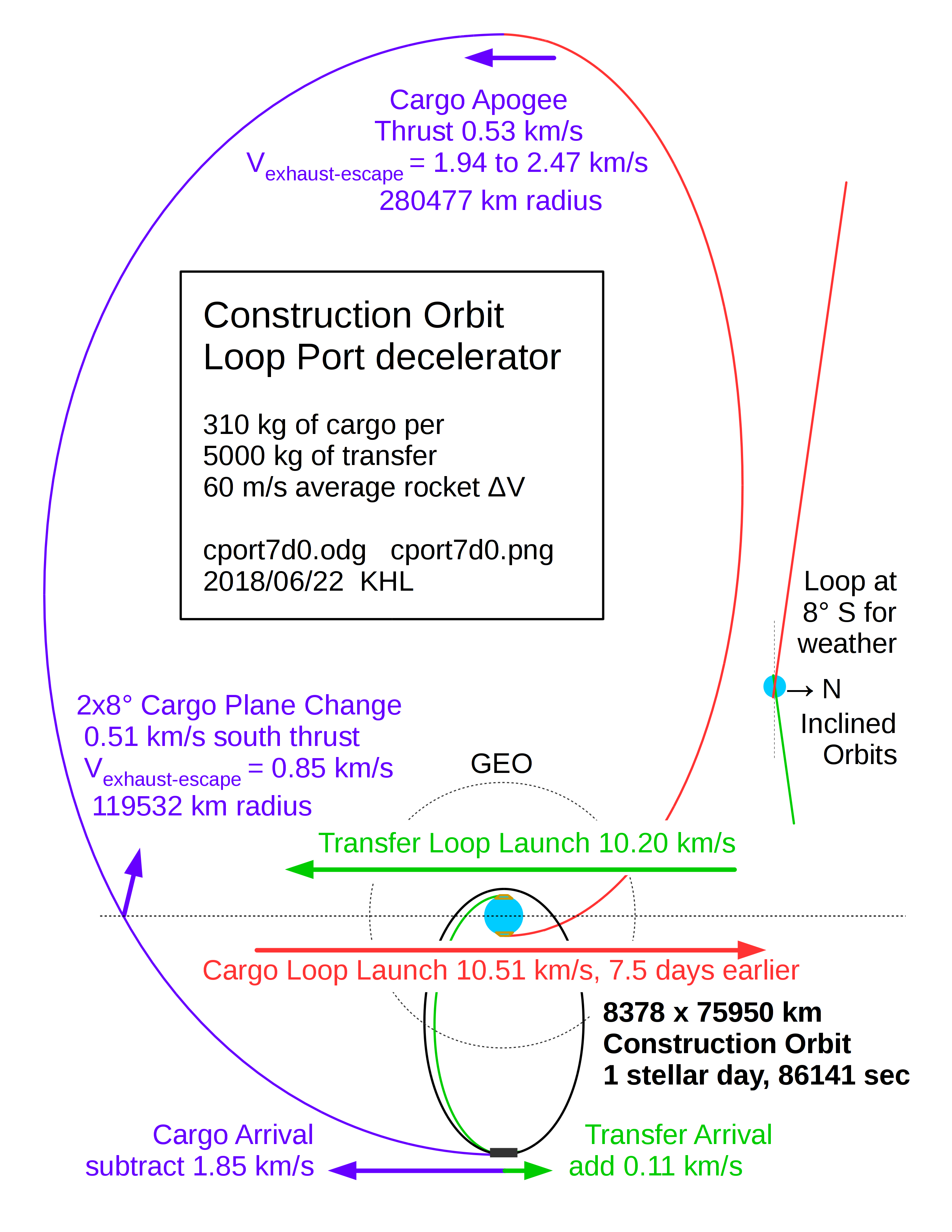|
Size: 2551
Comment:
|
Size: 3615
Comment:
|
| Deletions are marked like this. | Additions are marked like this. |
| Line 6: | Line 6: |
| || '''Slow cargo''' vehicles launch from the loop at 10,520 m/s to an apogee of 294730 km, approximately 7.5 stellar days before the launch of direct transfer vehicles. At apogee, an additional thrust of 503 m/s increases orbit velocity and raises perigee.<<BR>>The slow cargo vehicle is launched from the 8°S launch loop 7.5 days earlier than the direct transfer vehicle, placing its apogee on the opposite side of the Earth. '''Not directly opposite''', actually; because the loop is in the southern hemisphere, all launch apogees are in the northern hemisphere, so there is a 16° inclination difference between these two orbits.<<BR>>When the cargo orbit crosses the equatorial plane, a 506 m/s northward thrust changes the inclination to match the plane of the construction orbit and the direct vehicle trajectory. This plane occurs about 14 hours before arrival, and 3 hours before the direct vehicle is launched from the loop. At this point, the rocket motor and propellant tanks are jettisoned, and expend the last fuel launching to Earth escape velocity.<<BR>>The cargo vehicle arrives at 1868 m/s, and decelerates at 180 gees. Ship only sturdy cargo this way!|| | || '''Slow cargo''' vehicles launch from the loop at 10,520 m/s to an apogee of 294730 km, approximately 7.5 stellar days before the launch of direct transfer vehicles. At apogee, an additional thrust of 503 m/s increases orbit velocity and raises perigee.<<BR>>The slow cargo vehicle is launched from the 8°S launch loop 7.5 days earlier than the direct transfer vehicle, placing its apogee on the opposite side of the Earth. '''Not directly opposite''', actually; because the loop is in the southern hemisphere, all launch apogees are in the northern hemisphere, so there is a 16° inclination difference between these two orbits.<<BR>>When the cargo orbit crosses the equatorial plane, a 506 m/s northward thrust changes the inclination to match the plane of the construction orbit and the direct vehicle trajectory. This plane occurs about 14 hours before arrival, and 3 hours before the direct vehicle is launched from the loop. At this point, the rocket motor and propellant tanks are jettisoned, and expend the last fuel launching to Earth escape velocity.<<BR>>The cargo vehicle (more like an artillery shell!) arrives at 1868 m/s, and decelerates at 180 gees. Ship only sturdy cargo this way!|| |
| Line 10: | Line 10: |
| The two cargo orbit thrusts at a 90° angle from each other ''may'' provide enough degrees of freedom to correct large tidal perturbations from the Moon and the Sun (and small perturbations from Jupiter and Saturn). The high apogee of the cargo orbit will amplify the effect of these forces, which will vary over the month and the year. As an alternative to thrusters, rubber panels on the side of the vehicles may be laser-ablated to produce thrust. This will require a constellation of cooperative lasers. Vehicle position and orientation can be laser-measured to micrometer accuracy. This surprising capability is used to measure the positions of the [[ https://en.wikipedia.org/wiki/LAGEOS | LAGEOS ]] Laser Geodynamics Satellites, from the ground, through a turbulent atmosphere, with such high precision that the continental drift under the ground observatories can be measured. In vacuum, without seismic disturbances, accuracies can be fantastically high, LIGO measures differential distances to 23 decimal places. |
Construction Port
An Arnold-Kingsbury Space Port in a construction orbit, fed by a launch loop. Two streams of vehicles meet at the construction port at the 75950 km (radius) apogee of the geosynchronous (but not circular and geostationary!) 86164 second (one stellar day, which is a solar day minus 3 minutes and 56 seconds) construction orbit.
|
Direct transfer vehicles launch from the loop at 10,200 m/s (surface relative) to an apogee of 75950 km. However, they start with a perigee of 6458 km, not 8378 km like the construction orbit, so they arrive with a velocity deficit of 114 m/s. They are accelerated to construction port velocity in a "short" (1000 meter) Arnold-Kingsbury spaceport at 0.7 gees. |
Slow cargo vehicles launch from the loop at 10,520 m/s to an apogee of 294730 km, approximately 7.5 stellar days before the launch of direct transfer vehicles. At apogee, an additional thrust of 503 m/s increases orbit velocity and raises perigee. |
|
Both vehicles should be timed to arrive nearly simultaneously. This will minimize torque and displacement on the loop-port. Both vehicles will have "mousefart" thrusters for precision (millimeters!) alignment with the loop-port capture rails. |
|
Libreoffice drawing source file |
The two cargo orbit thrusts at a 90° angle from each other may provide enough degrees of freedom to correct large tidal perturbations from the Moon and the Sun (and small perturbations from Jupiter and Saturn). The high apogee of the cargo orbit will amplify the effect of these forces, which will vary over the month and the year.
As an alternative to thrusters, rubber panels on the side of the vehicles may be laser-ablated to produce thrust. This will require a constellation of cooperative lasers. Vehicle position and orientation can be laser-measured to micrometer accuracy. This surprising capability is used to measure the positions of the LAGEOS Laser Geodynamics Satellites, from the ground, through a turbulent atmosphere, with such high precision that the continental drift under the ground observatories can be measured. In vacuum, without seismic disturbances, accuracies can be fantastically high, LIGO measures differential distances to 23 decimal places.

